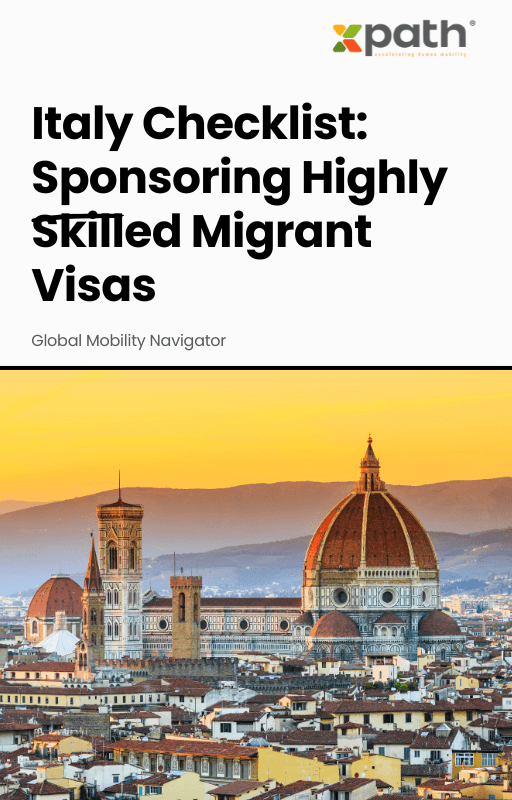Italy Checklist: Sponsoring Highly Skilled Migrant Visas
Grab a copy of a guide to international employee relocation
View E-bookAs organizations grow internationally, the complexities of relocating employees multiply—immigration rules, tax compliance, payroll, benefits, local labor laws, and culture-fit challenges pile up quickly. Manual processes or siloed systems can bog down HR and mobility teams, leading to costly errors, compliance risks, and, most importantly, a scattered employee experience.
Gartner’s 2023 study found that 80% of global mobility teams still rely on spreadsheets or disparate tools. This patchwork approach can cost companies unintended penalties or delays, and often leads to disjointed communication with employees embarking on international assignments. The writing is on the wall: advanced technology isn’t a luxury for global mobility teams—it’s a necessity.
Investing in a centralized global mobility platform pays dividends. Let’s look at the numbers. According to PwC’s 2022 Global Mobility Survey, companies leveraging dedicated global mobility software experienced a 25% reduction in assignment-related administrative costs and a 30% faster onboarding process for mobile employees. That’s not just faster paperwork; that’s real money and happier employees.
Moreover, platforms like xpath.global go beyond streamlining administration—they offer a seamless, compliant, and globally connected relocation journey. The data-driven insights provided empower organizations to optimize budgets, forecast future assignment needs, and manage vendor performance, all from a single dashboard. The result? Engaged talent, compliant moves, and measurable savings.
Consider the case of a multinational tech company handling over 500 global relocations annually. Before implementing xpath.global, their HR team juggled more than 12 different vendors and managed moves using shared spreadsheets and emails. The result: inconsistent data, missed compliance deadlines, and frustrated employees and assignees.
After adopting xpath.global, their HR team reported:
🔸40% reduction in assignment-processing time
🔸Complete visibility over the end-to-end mobility lifecycle
🔸Consistent compliance through automated immigration and tax workflows
🔸Enhanced employee satisfaction scores, with fewer last-minute surprises
The bottom line? Technology not only solved their headaches—it delivered direct ROI through better resource allocation, increased compliance, and happier, more productive assignees.
Even with numbers like these, HR and mobility leaders often face skepticism from finance teams or decision-makers. Common pushbacks include concerns about upfront costs, change management, or the perception that current systems are “good enough.” So, how do you break through?
The trick is speaking the language of business: quantify the costs of not upgrading. Calculate current manual hours spent on compliance, vendor chaos, error correction, and poor employee retention. Compare it decisively to anticipated savings and efficiency improvements. Don’t forget to showcase indirect benefits—like mitigating legal risks and protecting employer reputation.
The future of work is borderless—and the technology to manage mobile talent must keep up.
According to Deloitte’s 2023 Global Mobility Trends report, companies investing in AI-driven global mobility platforms forecast a 50% increase in program scalability over the next five years. More businesses now demand integrated mobility ecosystems—connecting legal, payroll, and travel data—enabling both compliance and strategic workforce planning.
Furthermore, as remote and hybrid assignments surge, the flexibility of solutions like xpath.global allows businesses to differentiate themselves as employers of choice and ensure a best-in-class employee experience irrespective of geography. That’s how you stay ahead—by investing wisely in technology that pays out over the long run.
Ready to pitch global mobility technology to your leadership team? Build your case step-by-step:
Remember, the strongest business cases are data-driven, future-focused, and human-centered. Don’t just talk about what the system will do—describe the better, smarter, and safer global workforce it will enable.
A global mobility solution is a technology platform or suite of tools that helps organizations manage employee relocations, international assignments, and workforce mobility with greater efficiency, compliance, and employee satisfaction.
Quantifying ROI involves assessing current inefficiencies (time, cost, errors) and projecting savings and improvements after implementation. Metrics include reduced administration, improved compliance, faster onboarding, and higher retention rates.
Xpath.global offers a comprehensive, centralized platform that integrates all aspects of the global mobility lifecycle—from compliance to employee experience—leading to real, quantifiable business outcomes for your organization.
Absolutely. A seamless relocation process boosts the employee experience, reducing frustration and increasing loyalty—critical for retaining top talent in global markets.
Ready to transform your mobility program? Explore xpath.global’s solutions.

Italy Checklist: Sponsoring Highly Skilled Migrant Visas
Grab a copy of a guide to international employee relocation
View E-book